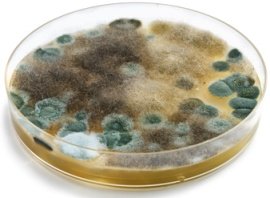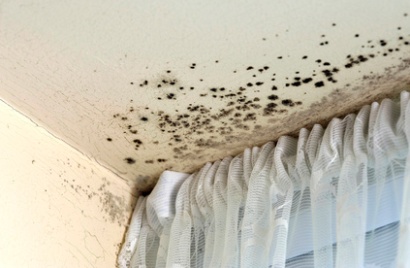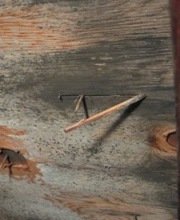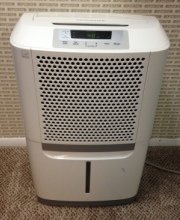Find a Mold Specialist Now
Click or Call, Toll-Free 24/7
Bipolaris Mold in the Home
Bipolaris mold is a common outdoor mold that frequently grows on grasses, plants and soil. In the home it may grow on houseplants, decaying food like celery or corn, or on water damaged materials such as sheetrock, carpeting or hardwood flooring.
A rapid growing mold, bipolaris appears soft or fluffy with color ranging from whitish to grayish brown as it starts to grow, and becoming dark olive or black as it matures, usually within five days. There are no known uses for bipolaris mold in an industrial or manufacturing setting.
Health Problems Caused by Bipolaris Mold

Bipolaris is a known allergen. Its large spores can easily spread through the air and be inhaled into the upper respiratory tract, causing nasal and sinus symptoms like runny or stuffy nose, asthma, coughing and wheezing. Some people also experience skin irritation like eczema and dermatitis (skin rash) from mold exposure. Here is more information about mold allergies.
Phaeohyphomycosis is a serious infection caused by bipolaris that affects the sinuses, and sometimes the skin, eyes and/or whole body. If the mold spores travel to the sinuses and attach to the mucus, they start to grow causing painful symptoms and permanent damage. These growths can block the nasal passages and sinuses, even pushing against the brain.
Both otherwise healthy individuals and immuno-compromised people can be affected by this disease. Because the symptoms initially present as a head cold or sinus infection, diagnosis can take months before patients and their doctors realize how serious the problem is. If you think you’ve been exposed to bipolaris and are experiencing sinus pain or stuffiness that won’t go away with regular treatment, see your doctor as soon as possible and mention that you think you have a mold infection. Treatment can include surgery and anti-fungal medication.
Some species of bipolaris mold produce a mycotoxin called sterigmatocystin, which has been shown to cause liver and kidney damage in lab animals. Its effects on humans are unknown.
What Do You Do If You Find Bipolaris Mold in Your Home?
Because it’s highly allergenic and can cause severe health problems, bipolaris needs to be removed from your home immediately. If you find celery or other root vegetables beginning to decay, bag the rotting food in plastic and dispose of it. Vacuum the surface where the food was stored with a HEPA vacuum and wipe it with a low-toxicity household cleaner.
If you see settled dust on packaged food items, dispose of any open packages as the mold spores may have settled inside. Use a damp wipe to clean the exterior of closed packages.
Bipolaris can grow on plants so look for signs of mold growth on your indoor plants. Typically, household plants grow a more harmless type of mold that can be readily scraped off the soil or wiped from the leaves. But you should avoid plant mold growth of any kind by not overwatering and ensuring that your plants have adequate drainage.

Preventing Mold Growth
Mold can be a dangerous and expensive problem in your home. In addition to the numerous health risks, unchecked mold growth can cause major damage to wood, drywall, ceilings, carpets and more. Left untreated, the mold can eventually affect the structural integrity of your home.
Although not all molds need a lot of moisture, it is the number one cause of mold growth in homes. Moisture can never be completely eliminated from your home, but you can keep it under control. Clean up water spills right away. Repair plumbing leaks quickly and make sure your kitchen and bathrooms are vented to the outside so humidity doesn’t build up. Use a de-humidifier or air conditioner, especially during summer months, to keep indoor humidity levels at no more than 50%.
Do You Need Professional Help?
If you find mold growing in your home, we recommend that you get a free home inspection from a local mold specialist. Prompt removal of mold can help prevent health issues from developing, and damage to your home from worsening. The mold specialist will go over the mold removal process, and provide a free estimate for professional remediation work. You can follow this link to get a list of mold removal profesionals offering free home inspections in your area.
For an area of 3 feet by 3 feet or smaller, you may choose to perform the mold removal yourself. Mold removal must be undertaken with proper precautions to prevent spreading or inhaling the spores. Personal protective equipment should include goggles, gloves and a mask or respirator. Plastic sheeting, duct tape and a HEPA vacuum are among the tools you’ll need to have available to keep the mold contained during removal.
If the area of mold growth is larger than 10 square feet, the U.S. Environment Protection Agency recommends professional mold remediation. They also encourage homeowners get professional help if you suspect there is mold in your home’s ductwork, or if you have allergies or other mold-related health problems. You’ll also want to consult a professional if your damage is the result of flooding or a sewage backup.
How to Select a Contractor
Your local handyman is probably not qualified to remove mold properly. Take the time to check references and make sure your contractor has experience and training in mold remediation. Talk to the person you hire about following the recommendations found in this guide. It’s important to protect the rest of your home during mold removal because mold spores travel so easily. Mold in one part of your home can cause you to have an allergic reaction anywhere in your home.
Return From Bipolaris Mold To Our Main Mold Types Page
Privacy Policy Terms and Conditions Accessibility Do Not Sell My Information Disclaimer Contact Us




